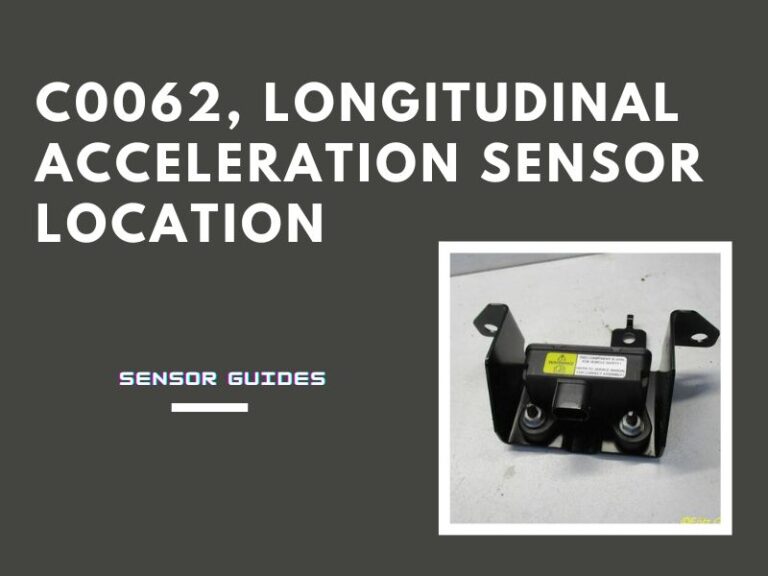5.9 Cummins Camshaft Sensor Location, Symptoms and Replacement
In this comprehensive article, we delve into the essential aspects of the 5.9 Cummins camshaft position sensor (CMP), covering its crucial role, common symptoms of sensor issues, and a step-by-step guide to replacing the CMP when needed.
Whether you’re a seasoned DIY enthusiast or a vehicle owner looking to understand your engine better, this article offers valuable insights into the location, symptoms, and replacement process of the 5.9 Cummins camshaft position sensor, empowering you to keep your engine running smoothly.
Table of Contents
What does the camshaft position sensor do in a 5.9L Cummins engine?
The camshaft position sensor (CMP) in a 5.9L Cummins engine plays a crucial role in the engine’s operation by monitoring the position of the camshaft. Here’s what the camshaft position sensor does:
- Timing Reference: The CMP provides a critical timing reference for the engine control module (ECM) or engine control unit (ECU). It informs the ECM about the exact position of the camshaft, which is responsible for controlling the opening and closing of the engine’s intake and exhaust valves.
- Fuel Injection Timing: The ECM uses the information from the CMP to precisely time the injection of fuel into the combustion chambers. Proper fuel injection timing ensures that the air-fuel mixture is delivered to the cylinders at the correct moment for efficient combustion.
- Ignition Timing (if applicable): In some engine configurations, particularly those with diesel engines, the CMP may also influence ignition timing. It helps ensure that the ignition of the air-fuel mixture occurs at the right moment for optimal engine performance.
- Synchronization: The CMP, in conjunction with the crankshaft position sensor (CKP), helps the ECM synchronize the engine’s various components, including the fuel injection system and the timing of the valves’ opening and closing.
- Diagnostic Function: The ECM uses the CMP’s data to monitor the camshaft’s position continuously. If there is any deviation or irregularity in the camshaft’s position, the ECM can detect it and trigger a diagnostic trouble code (DTC). This allows for the early detection and diagnosis of potential engine problems.
In summary, the camshaft position sensor in a 5.9L Cummins engine is critical for precise engine operation. It ensures that fuel injection and, if applicable, ignition timing are precisely coordinated with the camshaft’s position, leading to efficient combustion and engine performance.
If the CMP fails or provides incorrect data, it can result in symptoms such as starting issues, rough running, misfires, and loss of power, which can trigger a check engine light and diagnostic trouble codes.
6.7 Cummins Water in Fuel Sensor Bypass: Exploring Techniques and Considerations
sensor guides
Where is the Camshaft position sensor on a 5.9 Cummins?
The camshaft position sensor (CMP) on a 5.9L Cummins engine is typically located on the front of the engine, near the camshaft. However, it’s important to note that the exact location can vary slightly depending on the specific Cummins engine model and the vehicle it’s installed in.
Here are the general steps to locate the camshaft position sensor on a 5.9L Cummins engine:
- Open the Hood: Ensure the engine is off and the vehicle’s hood is open to access the engine compartment.
- Locate the Front of the Engine: Stand in front of the engine and look toward the front of the engine block.
- Look Near the Camshaft: The camshaft position sensor is typically located near the camshaft, often on the front side of the engine block. It will have a wiring harness connector that plugs into the sensor.
- Check the Engine Service Manual: To pinpoint the exact location, especially if you’re having trouble finding it, consult the engine’s service manual or the vehicle’s repair manual. These manuals provide detailed diagrams and descriptions of the sensor’s location and the removal/replacement procedure.
- Identify the Sensor: The camshaft position sensor will be a small, typically cylindrical or rectangular component with an electrical connector attached.
While the general location is near the camshaft at the front of the engine, the specific installation can vary based on the engine’s design and the vehicle it’s in. It’s essential to consult the appropriate service or repair manual for your specific Cummins engine model and vehicle to ensure accurate identification and location of the camshaft position sensor.
What are 5.9 Cummins camshaft position sensor symptoms?
A failing or malfunctioning camshaft position sensor (CMP) in a 5.9 Cummins engine can lead to various noticeable symptoms. Here are common symptoms that may indicate an issue with the CMP:
- Engine Starting Problems: A failing CMP can make it difficult for the engine to start. You may experience extended cranking times before the engine fires up or, in some cases, the engine may not start at all.
- Rough Idle: The CMP plays a crucial role in determining the timing of fuel injection and valve operation. A faulty sensor can lead to erratic fuel injection timing and valve timing, resulting in a rough or unstable idle. The engine may sputter, shake, or even stall while idling.
- Misfires: Incorrect camshaft position information can cause misfires in the engine’s cylinders. This leads to a lack of power, poor fuel efficiency, and a noticeable reduction in overall engine performance.
- Check Engine Light (CEL): When the CMP fails or sends erratic signals to the engine control module (ECM), it often triggers the Check Engine Light (CEL) on the vehicle’s dashboard. The CEL indicates a problem in the engine management system that requires attention.
- Reduced Fuel Efficiency: A malfunctioning CMP can disrupt the precise timing of fuel injection, leading to inefficient combustion. This can result in decreased fuel efficiency, which means you’ll need to refuel more frequently for the same amount of driving.
- Engine Stalling: In some cases, a failing CMP can cause the engine to stall while driving or when coming to a stop. This is often accompanied by a loss of power and may be a safety concern, especially at higher speeds.
- Hesitation and Lack of Acceleration: Problems with the CMP can lead to hesitation during acceleration. The engine may not respond promptly when you press the accelerator pedal, and you may notice a lack of power when trying to accelerate quickly.
- Reduced Overall Performance: Overall engine performance may be compromised, resulting in sluggishness, reduced power output, and a less enjoyable driving experience.
If you experience any of these symptoms in your 5.9 Cummins engine, it’s essential to have the camshaft position sensor and related components checked by a qualified mechanic. Ignoring these symptoms can lead to further engine problems and may result in more extensive and costly repairs down the road.
6.7 Cummins Mass Air Flow Sensor Problems: All Explained By Sensor Guides
Sensor guides
How to replace the 5.9 Cummins camshaft position sensor?
Replacing the camshaft position sensor (CMP) on a 5.9 Cummins engine is a relatively straightforward procedure. Here’s a step-by-step guide to help you replace the CMP:
Tools and Materials Needed:
- New camshaft position sensor
- Socket and ratchet set
- Extension bars
- Wrench set
- Clean rags
- Penetrating oil (if needed)
- Torque wrench
- Diagnostic tool (to clear trouble codes, if applicable)
Procedure:
- Safety Precautions:
- Ensure the engine is turned off and has had sufficient time to cool down.
- Disconnect the negative terminal of the vehicle’s battery to prevent electrical hazards.
- Locate the Camshaft Position Sensor:
- The CMP is typically located on the front of the engine near the camshaft. Refer to your vehicle’s service manual for the precise location.
- Remove the Old Sensor:
- Use a socket and ratchet or a wrench to loosen and remove the retaining bolt securing the CMP.
- Gently pull the old sensor out of its mounting position. It may be snug, so you may need to wiggle it while pulling.
- Be prepared for a small amount of engine oil to drip out when removing the old sensor. Have clean rags handy to catch any drips.
- Clean the Mounting Area:
- Use clean rags to wipe away any excess oil or debris from the sensor mounting area.
- Install the New Sensor:
- Apply a small amount of engine oil to the O-ring on the new CMP to ensure a good seal.
- Insert the new sensor into the mounting hole by hand. Do not force it.
- Hand-tighten the retaining bolt to secure the sensor in place.
- Torque the Retaining Bolt:
- Using a torque wrench, tighten the retaining bolt to the manufacturer’s specified torque value. Refer to your vehicle’s service manual for this value, as it can vary depending on the engine model.
- Connect the Wiring Harness:
- Plug the electrical connector from the vehicle’s wiring harness onto the new CMP.
- Reconnect the Battery:
- Reconnect the negative terminal of the vehicle’s battery.
- Clear Diagnostic Trouble Codes (if applicable):
- If the Check Engine Light (CEL) was illuminated due to the old CMP, use a diagnostic tool to clear any stored trouble codes from the vehicle’s engine control module (ECM).
- Test the Engine:
- Start the engine and monitor it for any unusual behavior. Check for rough idling, misfires, or stalling. Ensure that the Check Engine Light remains off.
- Road Test:
- Take the vehicle for a test drive to verify that it performs correctly and that the CMP replacement has resolved any previous issues.
Replacing the camshaft position sensor on a 5.9 Cummins engine is typically a DIY-friendly task. However, always consult your vehicle’s service manual for specific instructions and torque specifications to ensure a proper installation. If you’re not comfortable with these procedures, consider seeking the assistance of a qualified mechanic.







One Comment